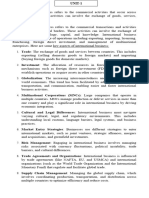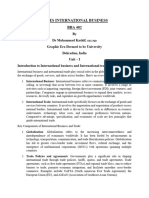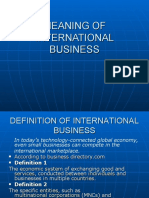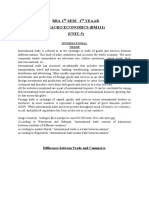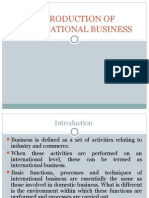0 ratings0% found this document useful (0 votes)
M1-LU1 International Trading
M1-LU1 International Trading
Uploaded by
roshanviasinternatoinal trading
Copyright:
© All Rights Reserved
Available Formats
Download as PDF, TXT or read online from Scribd
Download as pdf or txt
M1-LU1 International Trading
M1-LU1 International Trading
Uploaded by
roshanvias0 ratings0% found this document useful (0 votes)
internatoinal trading
Copyright
© © All Rights Reserved
Available Formats
PDF, TXT or read online from Scribd
Share this document
Did you find this document useful?
Is this content inappropriate?
internatoinal trading
Copyright:
© All Rights Reserved
Available Formats
Download as PDF, TXT or read online from Scribd
Download as pdf or txt
0 ratings0% found this document useful (0 votes)
M1-LU1 International Trading
M1-LU1 International Trading
Uploaded by
roshanviasinternatoinal trading
Copyright:
© All Rights Reserved
Available Formats
Download as PDF, TXT or read online from Scribd
Download as pdf or txt
You are on page 1/ 1
Import Export Procedures & Documentation
Module # 01 Learning Unit # 01
International Trading:
International trading refers to the exchange of goods and services across national
borders. It plays a crucial role in the global economy, allowing countries to specialize in the
production of goods and services in which they have a comparative advantage and to access
products and resources that are not available domestically.
Here are some key aspects of international trading:
1. Importing and Exporting: Countries engage in importing goods and services that they
cannot produce domestically or that are more cost-effective to obtain from other countries.
Conversely, exporting involves selling goods and services produced domestically to
customers in other countries.
2. Trade Agreements: Countries often negotiate trade agreements to facilitate international
trade by reducing tariffs, quotas, and other trade barriers. These agreements can be bilateral
(between two countries) or multilateral (involving multiple countries or regions).
3. Global Supply Chains: International trading has led to the development of complex
global supply chains, where components of a product may be sourced from multiple countries
before final assembly and distribution. This globalization of production has increased
efficiency but also introduced new challenges in terms of logistics, coordination, and risk
management.
4. Currency Exchange: International trading involves transactions in different currencies.
Exchange rates fluctuate based on various factors, including supply and demand, interest
rates, inflation, and geopolitical events. Currency exchange rates can significantly impact the
cost and profitability of international trade.
5. Trade Finance: Financing international trade transactions often requires specialized
financial instruments and services, such as letters of credit, trade credit insurance, and export
financing. These mechanisms help mitigate risks for buyers and sellers involved in cross-
border trade.
6. Regulatory Compliance: International trade is subject to various regulations and trade
policies, including customs procedures, import/export restrictions, trade sanctions, and
intellectual property rights protection. Compliance with these regulations is essential to avoid
legal and financial penalties.
7. Economic Impact: International trading can have significant economic impacts on
participating countries, influencing factors such as economic growth, employment, consumer
prices, and income distribution. It can also affect industries differently, creating winners and
losers depending on their competitiveness and adaptability to global market dynamics.
Conclusion:
Overall, international trading promotes economic interdependence and cooperation
among countries, fostering economic growth, innovation, and prosperity on a global scale.
You might also like
- New Balance Minimum Payment Due Payment Due Date: Account SummaryNo ratings yetNew Balance Minimum Payment Due Payment Due Date: Account Summary4 pages
- INTERNATIONAL BUSINESS MANAGEMENT Chapter 1-1No ratings yetINTERNATIONAL BUSINESS MANAGEMENT Chapter 1-138 pages
- European Union Mercosur: From Wikipedia, The Free EncyclopediaNo ratings yetEuropean Union Mercosur: From Wikipedia, The Free Encyclopedia3 pages
- Role of Banks in International Trade IMRAN ACANo ratings yetRole of Banks in International Trade IMRAN ACA20 pages
- BUS104 Introduction to International Trade NotesNo ratings yetBUS104 Introduction to International Trade Notes25 pages
- International Business Reading Material - DR Rajesh P GanatraNo ratings yetInternational Business Reading Material - DR Rajesh P Ganatra139 pages
- International Business: Dr. Dinkisa KenoNo ratings yetInternational Business: Dr. Dinkisa Keno30 pages
- Group 6 International Trade Written ReportNo ratings yetGroup 6 International Trade Written Report6 pages
- Global Trade Mastery: A Practical Guide to Export ExcellenceFrom EverandGlobal Trade Mastery: A Practical Guide to Export ExcellenceNo ratings yet
- International Business and Trade ReviewerNo ratings yetInternational Business and Trade Reviewer2 pages
- classical theory of international businessNo ratings yetclassical theory of international business10 pages
- Chapter - 1: Ntroduction TO Nternational BusinessNo ratings yetChapter - 1: Ntroduction TO Nternational Business13 pages
- Term Foreign Trade Defination:: Goods and Services100% (1)Term Foreign Trade Defination:: Goods and Services77 pages
- Smooth Sailing: A Quick Guide to Effective Cargo Import and Export: Logistics, #1From EverandSmooth Sailing: A Quick Guide to Effective Cargo Import and Export: Logistics, #1No ratings yet
- Yes.. Today Its Not Hard To Hear That We Can Make Withdrawals With Different Bank's ATMNo ratings yetYes.. Today Its Not Hard To Hear That We Can Make Withdrawals With Different Bank's ATM5 pages
- Report Parameters: Start Date End Date Resampled InputsNo ratings yetReport Parameters: Start Date End Date Resampled Inputs9 pages
- Arya Financial Services PROPOSAL - OCT - SMCCNo ratings yetArya Financial Services PROPOSAL - OCT - SMCC52 pages
- Account Number: 552592902 PIN CODE: 213996: Tax InvoiceNo ratings yetAccount Number: 552592902 PIN CODE: 213996: Tax Invoice2 pages
- A Study On Customers' Perception On Adoption of Digital Banking in Indian Banking SectorNo ratings yetA Study On Customers' Perception On Adoption of Digital Banking in Indian Banking Sector10 pages
- Localization Policy: Category Engine Capacity June-05 Targets (Isdp Points)No ratings yetLocalization Policy: Category Engine Capacity June-05 Targets (Isdp Points)19 pages
- Chapter 29 The Business Cycle, Inflation, and DeflationNo ratings yetChapter 29 The Business Cycle, Inflation, and Deflation51 pages
- Risk Management in Banking Principles and Framework Philip Te Z-LiborgNo ratings yetRisk Management in Banking Principles and Framework Philip Te Z-Liborg330 pages
- SAMPLE COVID EIDL Application (This Is A Sample Only)No ratings yetSAMPLE COVID EIDL Application (This Is A Sample Only)4 pages
- Online Mega Quiz - II ROUND (Stage - 1) - Khoj 2020 - Print Player - Quizizz VirenderNo ratings yetOnline Mega Quiz - II ROUND (Stage - 1) - Khoj 2020 - Print Player - Quizizz Virender4 pages
- Varian9e LecturePPTs Ch35 ExcternalitiesNo ratings yetVarian9e LecturePPTs Ch35 Excternalities117 pages
- Asep Eu Final Draft 2017 - Merged - Fin - 2No ratings yetAsep Eu Final Draft 2017 - Merged - Fin - 257 pages














